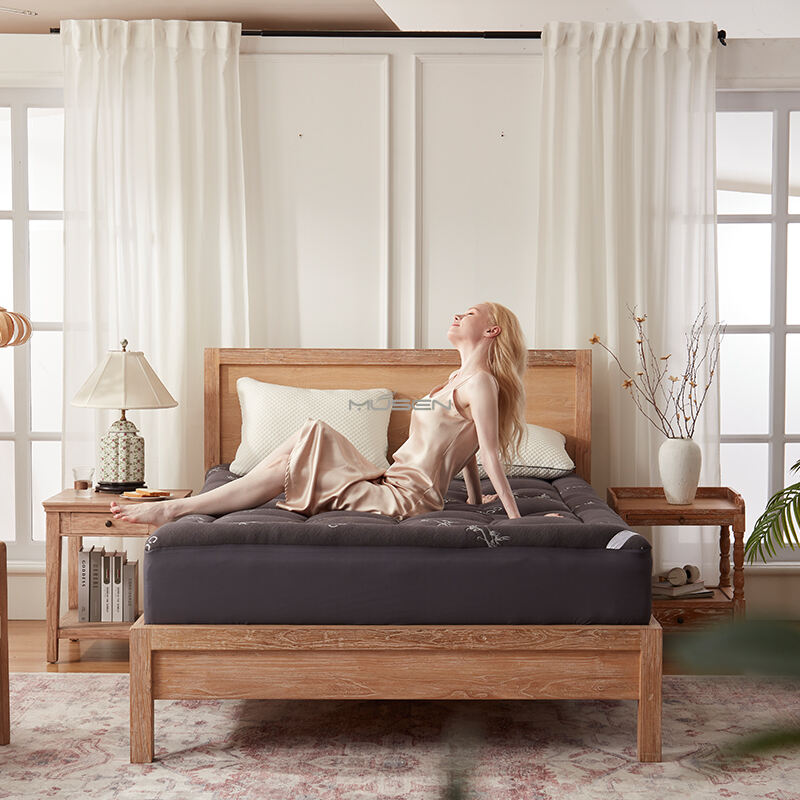
Light comforters actually help people sleep better because they work with how our bodies control temperature naturally. When it gets warm at night, these lighter blankets let excess heat escape instead of trapping it against the skin. On colder nights, they still manage to hold onto enough warm air without making us feel stuffy. Research shows that bedding materials which strike this right balance cut down on the need to constantly adjust covers during the night, keeping body temps around that ideal 37 degree mark or so according to a recent study published by Springer in 2024. Heavy blankets tend to make folks sweat through the night, whereas good quality lightweight comforters find that sweet spot between staying warm and allowing proper airflow throughout the sleeping hours.
A fill weight of 300 grams per square meter (gsm) offers ideal seasonal adaptability:
This weight reduces temperature-related wakefulness by 34% compared to heavier alternatives, according to the 2024 bedding materials report.
Fabrics like Tencel“ and organic cotton effectively transfer moisture away from the skin, preventing dampness, reducing microbial growth, and stabilizing the sleep microclimate. These materials absorb 30% more moisture than traditional cotton and dry 50% faster, based on textile engineering data.
| Material | Heat Retention | Moisture Management | All-Season Adaptability |
|---|---|---|---|
| Down | High | Moderate | Requires layering |
| Wool | Adaptive | High | Standalone efficacy |
| Polyester | Variable | Low | Limited breathability |
Natural fills such as wool and silk offer superior long-term thermal stability, maintaining performance over 3—5 years of regular use.
Baffle box construction forms 3D chambers that evenly distribute fill and eliminate cold spots, while enabling vertical air movement. Diamond-stitched channels reduce fabric tension, increasing airflow by 15—20% compared to traditional quilting. This design maintains insulation in cool months and prevents summer heat buildup through controlled ventilation.
Modern light comforters use gradient stitching—dense at edges, open in center zones—to cut material use by 18—22% while improving moisture dispersion. Slim profiles (1.5—2" thickness) feature aerated side panels that boost edge breathability by 30% in sleep system trials, easing layering without bulk.
High-grade microfiber shells with 400+ thread counts integrate nano-ventilation pores, allowing 1.2L/min of passive airflow. These features create the "Goldilocks effect"—balancing warmth and cooling through smart engineering rather than added weight.
A light comforter works as an effective base layer in winter, pairing with wool or fleece blankets for added warmth without heaviness. This modular approach preserves 85% of body heat while keeping total bedding under 4 lbs, supporting unrestricted movement. The 300—400 gsm range performs best, combining breathability with sufficient insulation.
In hot, humid environments, a standalone lightweight comforter with <150 gsm fill prevents overheating while offering gentle pressure for psychological comfort. Covers made from bamboo-derived rayon or Tencel“ enhance cooling, reducing nighttime temperature spikes by 2—3°F compared to standard cotton.
A 2023 thermal comfort study followed 112 participants using the same light comforter in Arizona (85°F nights) and Minnesota (15°F nights). Results showed:
Smart fill distribution—denser insulation near the torso, looser at extremities—enables adaptability across 50—75°F ambient temperatures.
Lightweight comforters use phase-change fabrics and hexagonal baffle stitching to manage heat. Tencel lyocell covers reduce humidity buildup by 34% compared to cotton (textile innovation studies 2024). Integrated airflow channels accelerate heat dissipation, meeting the preference of 68% of hot sleepers who prioritize breathability over insulation.
The 2024 Consumer Sleep Report found most temperature-sensitive individuals choose fills below 300 gsm for year-round use. Lower weights enable 22% faster heat redistribution and 19% fewer awakenings. Recent evaluations show synthetic down alternatives outperformed natural fills in humidity control for 83% of participants, confirming their value in managing heat.
 Hot News
Hot News2025-09-04
2025-09-02
2025-09-01
2025-07-08
2025-06-10
2025-11-27